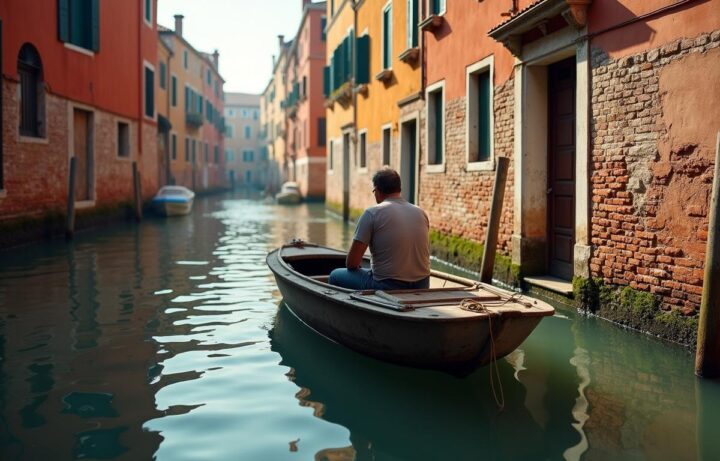What’s the True Cost of Living in Italy?
The cost of living in Italy is substantially less than in the US, with expenses ranging from 30% to 70% lower based on where you live. A typical family of four spends around €3,885 monthly, while single individuals manage with about €1,865. This Mediterranean gem stands out as more affordable than 71% of Western European countries, which attracts expats and digital nomads.

Italy presents excellent value compared to living costs in Portugal and other European destinations. The average monthly take-home pay reaches €1,619.81. Regional income differences paint an interesting picture. Northern Italian families earn over €35,000 yearly, while southern households typically bring in less than €26,000. Daily expenses tell a compelling story about Italy’s affordability versus the US. A cappuccino costs just €1.67, and a one-bedroom apartment’s utilities average €151 monthly.
Small Italian towns provide remarkable savings to retirees and long-term visitors. Rieti’s living costs can drop below $3,500 monthly. Three-bedroom homes rent for as little as $700. This piece explores Italy’s true living costs – from housing and utilities to healthcare and transportation. It gives expats a clear picture of yearly expenses they’ll face when choosing this beautiful country as their new home.
Breaking Down the True Cost of Living in Italy
Living in Italy comes with its own price tag, and you need to know the major expenses that will affect your budget. Your biggest monthly costs will be housing, utilities, and food. These expenses can look very different depending on where you live and how you choose to spend your money.
Housing Expenses: Rent or Buy?
Italy’s housing market looks different across its regions. Your choice between renting and buying mostly depends on your future plans and money situation. If you head over to northern regions like Lombardy, rent prices can reach €17.7 per square meter each month. The south tells a different story – in Sicily, you’ll find more budget-friendly options at about €7.5 per square meter.
The mortgage scene in Italy has become more welcoming to buyers. Interest rates on housing loans keep going down, and new loans averaged 3.18% in February 2025. The Italian mortgage market remains small compared to other European countries – it’s only 20% of GDP.
Here’s how rental costs change by location:
| Region | Monthly Rent per m² (€) |
| Valle d’Aosta | 20.6 |
| Lombardy | 17.7 |
| Tuscany | 16.3 |
| Molise | 6.3 |
Retirement planning in Italy might make you think about buying property in smaller towns. This is a big deal as it means that in some southern regions, homes start at €50,000 – that’s much cheaper than similar properties in Portugal.
Utilities and Internet Costs per Month
Living expenses in Italy include several key utility costs. An 85m² apartment’s utility bill (electricity, heating, cooling, water, garbage) runs about €193 monthly. Your actual costs will change based on how much you use and where you live.
Electricity bills have shot up lately. Italian households used to pay around €52 monthly before 2021. That number jumped to €85 per month between 2022-2023. Gas costs tell a similar story – people in Milan pay about three times more than those living in Palermo.
Internet prices stay pretty steady across Italy. Most people pay about €27 monthly for high-speed connections. Phone plans are a good deal too – you can get calls and 10GB+ data for just €11.59 monthly.
Food and Grocery Spending Habits
Food expenses in Italy reflect the country’s rich food culture. Each person typically spends €328.61 monthly on food.
Daily food costs average €10.60 per person with western eating habits. People who eat Asian-style meals might spend less – about €7.99 daily.
Big city grocery bills can catch you off guard. Milan tops the list as the priciest city with weekly grocery costs of €116. Aosta follows at €109.91, and Genoa comes in at €107.91. While Croatia’s cost of living might look similar, Italian food quality often makes the extra cost worth it.
Here’s what common groceries cost around the country:
- Milk (1 liter): €1.52
- Bread (daily for 2 people): €1.53
- Local cheese (500g): €7.00
- Chicken breasts (1kg): €10.60
Single people living in Italy usually spend €250-€300 monthly on groceries if they shop smart. Eating out doesn’t have to break the bank either – a basic meal at a casual restaurant costs around €15.

Hidden Costs You Might Not Expect
Life in Italy can catch expats off guard with unexpected expenses that aren’t obvious right away. The standard day-to-day costs are just the beginning – these hidden expenses can affect your budget a lot if you haven’t planned ahead.
Healthcare and Insurance Fees
The Italian healthcare system ranks among the world’s best, but expats need to understand how its financial structure works. The Italian National Health Service (Servizio Sanitario Nazionale or SSN) takes care of all citizens and legal residents through taxes instead of direct health insurance payments.
EU citizens can access healthcare easily, but non-EU foreign residents face a big change starting 2024. They now need to pay €2,000 yearly to access the national health service. This fee applies if you voluntarily register and don’t have a job in Italy. People with jobs must register with SSN through their employers.
A single person’s living costs in Italy should factor in these healthcare expenses:
- Family doctor visit: approximately €74
- Cold medicine (6-day supply): €8
- Antibiotic prescription: €12
Many expats add private insurance on top of public healthcare. Basic coverage costs between €150-€300 yearly, while detailed plans can go up to €600. Your yearly healthcare costs can vary greatly based on your job status and citizenship.
Taxes and Government Fees
The Italian tax system has several charges that often surprise newcomers. Property owners need to deal with multiple taxes:
- IMU (Municipal Property Tax): 7.6% of cadastral value for second homes
- TARI (Waste Tax): €100+ yearly based on property size and occupants
- TASI (Municipal Services Tax): 1-3.3% of property value
Italian income tax works on a progressive system from 23-43%, plus extra regional taxes (0.8-3.33%) and municipal taxes (0-0.9%). Living costs in Italy vs US still work out better for many expats because other expenses are lower.
The Italian system has some unique taxes too. Your electricity bill automatically includes a TV ownership tax, whatever channels you watch. You’ll keep paying this fee until you officially declare you don’t own a TV – something you need to do every year.
Car expenses in Italy can get pricey. Road taxes change by region and engine size. Insurance in cities like Florence costs “ridiculously expensive” because of high accident rates. Transportation ends up costing way more than you’d predict compared to Portugal or other European spots.
Unexpected Maintenance and Repairs
Italian homeowners face different maintenance responsibilities and costs than other countries. Building owners handle common area maintenance in multi-tenant buildings, while tenants take care of interior upkeep. Apartment buildings charge condominium fees ranging from €500 to €5,000 yearly depending on extras like concierge services and pools.
Fixing up an older property – something many expats love – can cost quite a bit:
- Roof renovation: €180-€200 per square meter
- Floor replacement: €18-€70 per square meter
- Kitchen remodeling: €3,000-€5,000 total
- Bathroom renovation: €800-€1,200 per square meter
These costs really add up in your retirement budget, especially during your first few years after moving. Italian paperwork makes everything more complex – you need building permits (Permesso di Costruire) to do major construction or demolition work.
House insurance costs property owners €180-€380 yearly depending on location and coverage. A property administrator who handles paperwork and payments charges €100-€150 yearly – money well spent if you struggle with language barriers and complex Italian rules.
Cost of Living in Italy vs US: A Real Comparison
The numbers tell quite a story when you look at living costs between Italy and America. The contrast is striking, and it’s easy to see why many expats pick Italy for both quality and affordability.
Housing and Rent Differences
You’ll notice Italy’s cost advantage most clearly in housing expenses. US housing prices are a big deal as it means that they’re 117.3% higher than Italian prices. A one-bedroom apartment in an Italian city center will set you back €743 monthly. The same setup in the US costs around €1,530 – that’s 105.9% more. The gap gets even bigger outside city centers, jumping to 122.3%.
The property market shows an interesting flip in city centers. Italian properties cost 23.5% more per square meter compared to their American counterparts. This makes renting a great option for expats who plan to retire in Italy.
Food and Dining Out Costs
Food costs show another clear difference between Italy and America. US grocery shopping costs 22.2% more than in Italy. To name just one example, see how a kilogram of apples costs €2.17 in Italy but jumps to €4.64 in America – an eye-opening 113.8% difference.
What does a single person spend on meals in Italy? Restaurant prices show a smaller but notable gap, with US restaurants costing 15.7% more. A cappuccino in Italy costs just €1.67, while Americans pay €4.60. Monthly food expenses for one person average €488 in Italy compared to €609 in the US.
Italy stays competitive with its food prices while offering better quality and variety than places like Portugal or Croatia.
Transportation and Fuel Expenses
Transportation is one area where Italian living costs can actually top American expenses. Public transportation is cheaper and more available in Italy, with monthly passes costing 58.7% less than in the US. The fuel prices tell a different story though.
Italian gasoline costs about €1.79 per liter while Americans pay just €0.81 – that’s a huge 54.4% difference. The 2023 numbers show Italians paid around USD 7.52 per gallon while Americans paid USD 3.75.
The good news? Italian cities have such effective public transportation that you might not need a car for daily life. This balances out the US-Italy cost difference in this category. Your yearly budget could benefit a lot, especially if you live in urban areas.

Average Cost of Living in Italy for a Single Person
Living single in Italy brings its own financial challenges. Let’s take a closer look at what it really costs to live solo in this beautiful country.
Sample Monthly Budget for Singles
A single person’s cost of living in Italy ranges from €1,400-€1,600 monthly with rent. Singles pay about €571 more each month than couples who split their expenses. Here’s a complete monthly budget breakdown that shows where your euros go:
| Housing | €600 |
| Food | €480 |
| Healthcare/Insurance | €100 |
| Utilities | €540 |
| Transportation | €267 |
| Entertainment/Miscellaneous | €330 |
| Total | €2,317 |
This budget comes from Rieti, a small town northeast of Rome, and shows how location shapes your living costs. The same lifestyle costs about €1,654 monthly in Milan, while you could live on just €838 in Palermo.
Living costs in Italy stack up differently against Portugal. Both countries offer affordable Mediterranean lifestyles. Italians spend around €1,796 monthly on simple expenses like housing, utilities, transportation, and groceries.
Tips to Stretch Your Budget Further
Smart timing of your move can substantially cut your living costs compared to US expenses. Moving during off-season (November through March) gets you better housing rates with fewer tourists.
Shopping like locals helps save money. Italians buy fresh food in smaller amounts more often. This prevents waste and saves money over time. Eating seasonal food cuts costs and gives you better quality—you won’t find summer fruits like strawberries and watermelon in winter, and they’re expensive anyway.
Transport costs add up fast, so think over if you need a car. Public transport in major cities costs about €35 monthly, which beats paying for car maintenance, gas, and insurance.
Monastery and convent stays are worth looking into. They provide simple facilities at good prices, though they come with curfews. Many expats have used this option to adjust to Italian costs before settling permanently in Croatia and nearby areas.
You’ll manage Italian living costs better by adopting local habits—keeping cars longer, using hand-me-downs, and cooking at home more often. These lifestyle changes make yearly retirement expenses more manageable.
Smart Ways to Save Money While Living in Italy
Living in Italy doesn’t require sacrifices – just smart choices. Your cost of living can drop when you make informed decisions about where to live, how to shop, and getting around. These choices help you maintain a great quality of life without breaking the bank.
Choosing the Right City or Town
Living costs vary across Italian regions. Milan and Rome demand premium prices in the north, while southern regions help you save more. Palermo, Sicily stands out as Italy’s most affordable city, where monthly expenses average around €1,100. Bari in Puglia blends affordable living with stunning beaches and historic architecture – a perfect retirement destination.
You’ll find budget-friendly cities like Pescara (€1,300/month), Rieti (€1,100/month), and Campobasso (€1,040/month). Housing costs in these smaller towns are half of what you’d pay in major cities. This makes a vital difference since accommodation takes up the biggest chunk of living expenses for a single person in Italy.
Shopping Local and Seasonal
Italian markets serve as cultural landmarks and money-saving destinations. Weekly markets pop up in every town and city. These spots sell seasonal produce, clothing, and homeware at prices lower than retail stores. Market shopping cuts food costs and offers better quality compared to Portugal or other European destinations.
Italian shoppers buy fresh food in smaller amounts more often. The rhythm of seasonal eating – summer tomatoes and winter citrus – connects you to local life while keeping costs reasonable. Market prices are a great deal, from €1.06 for fresh tomatoes to €2.54 for six bananas.
Using Public Transport Smartly
Transport takes up much of your monthly budget. Yet Italy offers better value than living costs in Croatia and other European spots. Most Italians use public transport because of shorter distances and restricted traffic in historic centers.
City transit tickets cost under €2, and monthly passes range from €35-55. Long-distance travel becomes cheaper with advance planning. Early bookings can get you high-speed train tickets from Rome to Florence for just €16. Daily, weekly, or 72-hour passes pay for themselves after a few trips throughout the year.
Cost of Living in Italy Frequently Asked Question
How Much Does It Cost for A Single Person to Live in Italy per Month?
The average monthly cost for a single person in Italy ranges from €1,400 to €2,300, depending on the location. This typically includes rent, food, utilities, transportation, and other basic expenses. Costs are generally lower in southern regions and smaller towns compared to major northern cities.
Is Healthcare Expensive for Expats in Italy?
Healthcare costs in Italy can vary for expats. EU citizens have easier access to the national health service, while non-EU residents now face a €2,000 annual fee for voluntary registration. Many expats choose to supplement public healthcare with private insurance, which can cost between €150-€600 annually depending on the coverage level.
How Do Food Costs in Italy Compare to the United States?
Food costs in Italy are generally lower than in the United States. Grocery shopping in Italy is about 22% cheaper, and restaurant prices are approximately 16% lower. A typical Italian household spends around €329 per person monthly on food, while daily food expenses average about €10.60 per person following western eating habits.
What are Some Unexpected Costs of Living in Italy?
Some unexpected costs in Italy include property taxes for homeowners, television ownership tax added to electricity bills, and potentially high car insurance rates in metropolitan areas. Additionally, condominium fees in apartment buildings can range from €500 to €5,000 annually, depending on amenities.
How can I Save Money While Living in Italy?
To save money in Italy, consider choosing a smaller town over a major city, shopping at local markets for fresh, seasonal produce, and utilizing public transportation instead of owning a car. Embracing Italian lifestyle habits like buying groceries in smaller quantities more frequently and cooking at home can also help reduce expenses significantly.
What is the Cost of Renting an Apartment in Major Italian Cities?
Rent prices vary significantly between cities in Italy. In Rome and Milan, a one-bedroom apartment in the city center can cost between €1,000 and €1,500 per month, while in smaller towns or suburban areas, similar accommodations may be found for as low as €500–€800. Rent is one of the largest components of monthly expenses for both locals and expats.
Are Utilities Expensive in Italy?
Monthly utility bills in Italy, including electricity, heating, cooling, water, and garbage, typically cost between €120 and €200 for a standard 85 m² apartment. Internet services range from €25 to €40 per month. Prices may fluctuate based on location, season, and the energy provider chosen.
How Much Do Transportation Costs Add to the Monthly Budget?
Public transportation in Italy is affordable and efficient, especially in urban areas. A monthly transit pass generally costs €35 to €55, depending on the city. Those who own a car should budget for fuel (€1.80–€2.00 per liter), insurance, tolls, and occasional repairs, which can significantly increase monthly expenses.
What is the Average Cost of Dining Out in Italy?
Dining out in Italy can be quite affordable. A meal at an inexpensive restaurant usually costs around €15, while a three-course meal at a mid-range restaurant averages between €25 and €40 per person. Pizza, panini, and espresso-based meals offer low-cost yet authentic experiences that locals and expats alike enjoy.
How Much Does Childcare and Education Cost in Italy?
Public schooling is free and of high quality in Italy, but private international schools can cost from €5,000 to over €20,000 per year. For younger children, daycare or preschool services typically range from €300 to €600 per month, with lower costs in smaller towns or through public programs.


